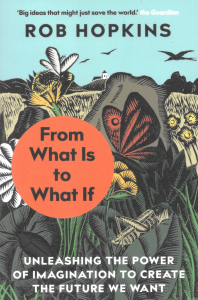The one-sentence summary
If we unleash the power of imagination, we can create the future we want.
Can’t be bothered to read it? Listen to the 5-minute summary in two parts.
Want to buy the book? CLICK HERE
WHAT THE BOOK SAYS 
- The author asks the most important question that society has somehow forgotten. What If? explores what we must do to revive and replenish our collective imagination. Answering it can change societies and cultures rapidly, dramatically and unexpectedly for the better. There really is no end to what we can accomplish.
- The questions posed include:
- What if we took play seriously?
- What if we considered imagination vital to our health?
- What if we followed nature’s lead?
- What if we fought back to reclaim our attention?
- What if school nurtured young imaginations?
- What if we became better storytellers?
- What if we started asking better questions?
- What if our leaders prioritized the cultivation of imagination?
- What if all this came to pass?
- Answers to these could lead to a positive expression of how the future might turn out. If we wait for governments, it will be too late. If we act as individuals, it will be too little. But if we act as communities, it might just be enough, and it might just be in time.
- Imagination is a fundamental part of being human, it is our natural state, and it is resilient, so if we can push aside the factors that are depressing it, it will reemerge. The pressures of modern life involve some shocking statistics:
- Shit Life Syndrome (SLS) is what doctors call a tangled mix of economic, social and emotional problems which consists of low mood caused by adverse life circumstances. Anxiety disorders have increased twentyfold in the past thirty years and 83% of people say they spend no time at all relaxing or thinking.
- 71% of adults in 2007 played in the street when they were kids, by which time the figure for their children had dropped to 21%. This has been described by Richard Louv as ‘well-meaning, protective house arrest.’
- Three quarters of UK children spend less time outdoors than inmates of the US prison system, while the average American spends 93% of their time either indoors or in vehicles.
- In 2018, the average total media consumption for US adults (that’s electronic media, TV, radio, online, gaming and smartphones) was 11 hours and 6 minutes a day, up from 9 hours 32 minutes in 2014. This is a daily battle with distraction.
- Sherry Turkle says that we are being silenced by our technology – in a way, cured of talking. It would take 417 hours to read 200 books in year, which sounds like a lot, but is considerably less than the 608 hours the average American spends on social media every year or the 1,642 hours watching TV.
WHAT’S GOOD ABOUT IT
- Art helps people with mental difficulties in many ways: it is another form of communication, it is (or can be) a social activity, it’s a challenge, it’s educational, it can be collaborative, the process is therapeutic, anyone can do it, you can share it with others in your community, and it’s a meaningful activity which reduces isolation and improves your life.
- Disimagination machine is a phrase coined by Henry Giroux. It refers to state and corporate sponsored ignorance, produced mainly through mainstream media and the public relations industries, to erase selected elements of history, disdain critical thought, reduce dissent to a species of fake news, and undermine the social imagination.
- Richard Sennett says that modern capitalism works by colonizing people’s imagination of what is possible. Thomas Piketty shows how the creation of inequality is fundamental to capitalism’s model. It thrives by imagining us as isolated consumers, cultivating desire for things we don’t need, and a sense of inadequacy if we fail to attain them. By promoting the myth that the route to happiness is the accumulation of stuff, capitalism is therefore a mental illness generating system.
- The Executive Control Network (ECN) in our brains is engaged when we actively focus on a task, but the Default Mode Network (DMN) is for reflection and daydreaming. This is where attention and imagination meet.
- The only people expected to be always-on, managing a steady stream of information, are air traffic controllers, and for that reason they are only allowed three-hour shifts.
- Digital minimalism involves reviewing every tech tool that you use, embarking on a 30-day declutter, and only reinstating them if they serve a very specific purpose.
- Multitasking doesn’t work because we don’t have enough attention for it – so we overload the brain and end up doing more things badly.
- The internet is the mental equivalent of junk food, sometimes called a toxic mimic, that plays on our inherent interest in storytelling but delivers very little value and leaves us with a nagging sense that we could have used our time better.
- According to Tatsuyoshi Saijo, futureability is an increase of happiness as a result of deciding, and acting, to forgo current benefits as long as it enriches future generations.
WHAT YOU HAVE TO WATCH
- Not much. There are a fair number of local examples but they all serve to inspire and illustrate the main argument.
